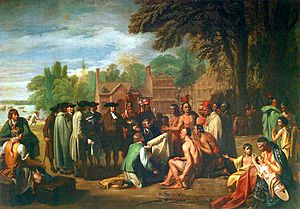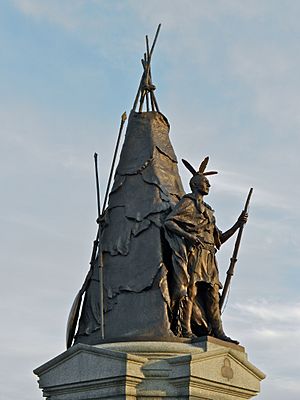Tamanend facts for kids
Quick facts for kids
Tamanend
|
|
|---|---|

The Treaty of Penn with the Indians by Benjamin West, showing Penn meeting Tamanend
|
|
| Lenni-Lenape leader | |
| Personal details | |
| Born | c. 1625 North America |
| Died | c. 1701 North America |
Tamanend (born around 1625, died around 1701) was a very important leader of the Lenni-Lenape people. He was the Chief of Chiefs and led the Turtle Clan in the Delaware Valley. Tamanend is famous for signing a peace treaty with William Penn, who founded Pennsylvania.
People also called him "Tammany," "Saint Tammany," or "King Tammany." He became a popular hero in America during the 1700s, especially in Philadelphia. Many saw him as a symbol of peace and friendship. Later, groups called Tammany societies were formed across the United States. They celebrated him as a symbol of peaceful talks and agreements.
Contents
Tamanend's Life and Story
Tamanend was part of a big meeting between the Lenni-Lenape leaders and the leaders of the Pennsylvania colony. This meeting happened under a large elm tree in a place called Shakamaxon in the early 1680s. William Penn and Tamanend signed several peace agreements, starting in 1683.
Tamanend is remembered for saying that the Lenni-Lenape and the English colonists would "live in peace as long as the waters run in the rivers and creeks and as long as the stars and moon endure." These powerful words are even carved on a statue of Tamanend in Philadelphia today.
It is thought that Tamanend passed away in 1701. After he died, many stories grew around him. People in Philadelphia started calling him "King Tammany" or "Saint Tammany." They even called him the "Patron Saint of America."
People in Philadelphia created a Tammany society and held a yearly festival to honor him. These traditions soon spread across America. Tamanend became a popular symbol because colonists wanted to show they were "American," not just from Europe. He represented this new American spirit.
Because Philadelphia was a very important city during the American Revolutionary War, Tamanend became a national symbol. Several of Tamanend's grandchildren also became important Lenape chiefs and warriors. These included Pisquetomen, Nenatcheehunt, Shingas, and Tamaqua.
Tamanend's Lasting Impact
Tammany Societies
In 1772, the first Tammany Society was started in Philadelphia. It was first called the "Sons of King Tammany." Later, its name changed to the "Sons of St. Tammany." Soon, similar groups appeared all over the United States.
The most famous of these was the Society of St. Tammany in New York City. Its members created a powerful political group known as "Tammany Hall." A white marble statue of Tamanend decorated the front of the Tammany Hall building.
Tammany Festivals
By the early 1770s, yearly Tammany Festivals were held in cities like Philadelphia. These festivals took place on May 1st. They replaced older European traditions like May Day but kept some of the fun folk customs. For example, a festival in 1771 had a may pole decorated with ribbons. People danced around it in a style similar to American Indian dances.
On May 1, 1777, John Adams wrote about the Tammany festival in Philadelphia. He was there for the Second Continental Congress. Adams wrote to his wife, Abigail Adams, saying:
This is King Tammany's Day. Tammany was an Indian King, of this part of the Continent, when Mr. Penn first came here. His court was in this town. He was friendly to Mr. Penn and very serviceable to him. He lived here among the first settlers for some time and until old age. ... The people here have sainted him and keep his day.
On May 1, 1778, General George Washington and the Continental Army also held a Tammany festival. They were camped at Valley Forge during the Revolutionary War. The soldiers "spent the day in mirth and jollity...in honor of King Tammany."
After the war, Tammany celebrations became popular across the United States. Local groups held yearly festivals, usually on May 1st. These events were so important that George Washington attended a Tammany festival in Richmond, Virginia, in 1785. The Tammany Society in New York City held its first festival in 1787.
In 2003, some members of the United States Congress tried to make May 1st "St. Tammany Day." This would have been a national day of recognition. The Senate agreed to this idea, but the House of Representatives did not take action. So, it did not become a national day.
Statues and Memorials

- A wooden statue of Tamanend was made in 1817 by William Luke. It was the figurehead on the warship USS Delaware. The ship was later burned, but the statue was saved. Today, it is displayed at the United States Naval Academy in Annapolis, Maryland. A bronze copy stands outside a building there.
- A bronze statue of Tamanend was created in 1995 by Raymond Sandoval. It is located in Philadelphia, Pennsylvania. A sign there says that Tamanend was seen as the "patron saint of America" before the country became independent.
Places Named After Him
Many places and things have been named after Tamanend:
- St. Tammany Parish (a county in Louisiana) was named around 1810. It is the only one of Louisiana's "saint" parishes not named after a Christian saint.
- Mount Tammany is a mountain peak in New Jersey, near the Delaware Water Gap.
- The "Tammany Regiment" was the nickname for the 42nd New York Volunteer Infantry Regiment during the American Civil War. Their monument at the Gettysburg Battlefield includes a statue of Tamanend.
- Tamanend Middle School in Pennsylvania is named for him.
- The town of Bracey, Virginia, was originally called St. Tammany.
- St. Tammany Masonic Lodge #5 was started in Hampton, Virginia, in 1759.
- Todd Tamanend Clark, a poet and composer, was born in Pennsylvania in 1952.
See also
- List of peace activists


